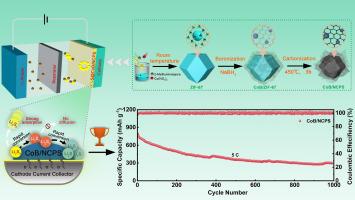通过继承了金属有机框架多面体形态的 CoB/NCPS 复合材料,为吸附/催化多硫化物转化提供强大协同效应的硫宿主设计
IF 13.3
1区 工程技术
Q1 ENGINEERING, CHEMICAL
引用次数: 0
摘要
作为下一代储能系统的理想选择,锂硫(Li-S)电池的高比容量和能量密度备受关注。实际上,由于多硫化锂(LiPSs)的 "穿梭效应 "和缓慢的转换动力学,高能量密度锂硫电池面临着挑战,而多功能材料可以成功地规避这些问题。在此,我们报告了一种基于新型硼化钴(CoB)合金的硫阴极,这种合金均匀地分布在掺氮碳多面体外壳(CoB/NCPS)上。在我们的构想中,ZIF-67 被部分还原成 CoB 合金作为催化剂,同时作为催化剂支持物仍保留其原有的多面体形态,通过进一步热解,这将大大有利于硫阴极的电化学性能。正如所预期的那样,S@CoB/NCPS 阴极在 1C 时的初始放电比容量高达 1022.3 mAh/g,甚至可以承受高达 5C 的高速率,初始容量为 782.7 mAh/g,并且在 1000 个循环周期内实现了每循环 0.06% 的超低容量衰减率。这项研究不仅证明了作为硫宿主的 CoB/NCPS 复合材料在硫/LiS 氧化还原转化反应中具有非凡的吸附性能和优异的电催化活性,而且为在锂硫电池中制备具有完美形貌的金属硼化物提供了一种可行的策略。本文章由计算机程序翻译,如有差异,请以英文原文为准。

A Sulfur-Host design for Adsorption/Catalysis strong synergy on polysulfide conversions via CoB/NCPS composites inheriting the polyhedron morphology of Metal-Organic framework
As a promising option for next-generation energy storage systems, the high specific capacity and energy density of lithium-sulfur (Li-S) battery have attracted significant attention. Actually, high-energy–density lithium-sulfur batteries face challenges due to the “shuttle effect” and slow conversion kinetics of lithium polysulfides (LiPSs), which can be successfully circumvented by multifunctional materials. Here, we report a sulfur cathode based on a new type of cobalt boride (CoB) alloy which is uniformly distributed on the nitrogen-doped carbon polyhedral shell (CoB/NCPS). In our conception, ZIF-67 is partially reduced to form the CoB alloy as catalyst while still retains its original polyhedron morphology as the catalyst supporter, which would be much beneficial to the electrochemical performance of the sulfur cathode through further pyrolysis. As expected, the resultant S@CoB/NCPS cathode enables an initial discharge specific capacity as high as 1022.3 mAh/g at 1C, and can even endure a high rate up to 5C with an initial capacity of 782.7 mAh/g and deliver an ultralow capacity decay rate of 0.06 % per cycle over 1000 cycles. This study not only demonstrates that the CoB/NCPS composites as sulfur host have the extraordinary adsorption performance and excellent electrocatalysis activity in the redox conversion reaction of sulfur/LiS, but also provides a tractable strategy for the fabrication of metal borides with perfect morphology in lithium-sulfur batteries.
求助全文
通过发布文献求助,成功后即可免费获取论文全文。
去求助
来源期刊

Chemical Engineering Journal
工程技术-工程:化工
CiteScore
21.70
自引率
9.30%
发文量
6781
审稿时长
2.4 months
期刊介绍:
The Chemical Engineering Journal is an international research journal that invites contributions of original and novel fundamental research. It aims to provide an international platform for presenting original fundamental research, interpretative reviews, and discussions on new developments in chemical engineering. The journal welcomes papers that describe novel theory and its practical application, as well as those that demonstrate the transfer of techniques from other disciplines. It also welcomes reports on carefully conducted experimental work that is soundly interpreted. The main focus of the journal is on original and rigorous research results that have broad significance. The Catalysis section within the Chemical Engineering Journal focuses specifically on Experimental and Theoretical studies in the fields of heterogeneous catalysis, molecular catalysis, and biocatalysis. These studies have industrial impact on various sectors such as chemicals, energy, materials, foods, healthcare, and environmental protection.
 求助内容:
求助内容: 应助结果提醒方式:
应助结果提醒方式:


